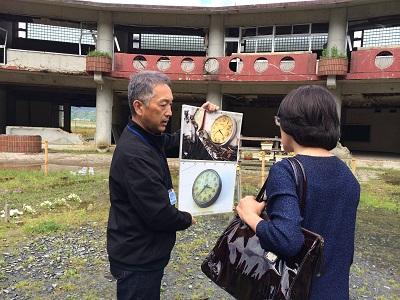
Noriyuki Suzuki who lost his daughter Mai in the 2011 tsunami shows UNISDR head, Mami Mizutori, a photo of the Okawa school clock which stopped at the time the tsunami hit. 74 children and ten teachers lost their lives at the school.
By Yuki Matsuoka
Kobe, 23 May, 2018 - Two schools with tragically different experiences of the 2011 Great East Japan Earthquake and Tsunami were at the centre of Ms. Mami Mizutori’s first visit to her native Japan since she took on the role of UN Special Representative for Disaster Risk Reduction in March.
Last Saturday, the head of UNISDR, Ms. Mizutori, was in the Tohoku region, where she visited Okawa Elementary School which lost 74 students and ten teachers in the tsunami that followed the magnitude 9 earthquake on March 11, 2011. In April this year, the Sendai High Court ruled that the deaths could have been prevented if a disaster contingency plan had been updated.
She heard the story of what happened on that day from Mr. Noriyuki Suzuki, who lost his daughter, Mai, a 6th grade student in the Okawa Elementary School.
"Learning from the tragedy that happened in this school, evacuation drills have to be practical and practiced regularly to save the lives of children. This tragic site should become a place where education for Bosai (disaster risk reduction in Japanese) should take place and spread a strong message to the world", Mr. Suzuki said.
Ms. Mizutori also visited the Arahama Elementary School in Sendai City where all the students survived even though it was almost completely submerged in the tsunami. The site of the Arahama Elementary School was opened as a memorial facility in April 2017 where visitors can learn the story of how the 320 people including students, staff and local residents survived the tsunami. Many of them were rescued from the roof.
Their survival stories provide evidence of how preparedness measures put in place by the school worked. One year before the disaster, evacuation plans to the upper floors were revised and emergency goods were moved to the 3rd floor from the 1st floor.
"The Japanese word Kizuna means bonds or ties in a community. Kizuna in a community is critical for disaster risk reduction and building back better from disasters. This is something we have to foster through our daily life, not start trying for the first time when a disaster happens", Ms. Mizutori said after meeting with groups of survivors.